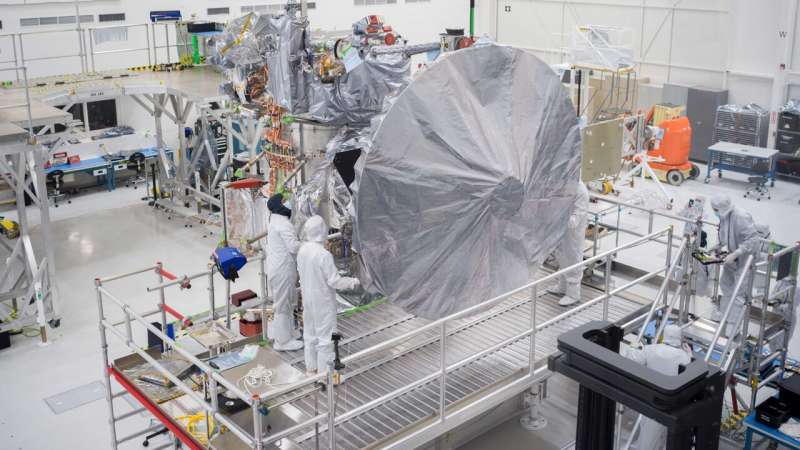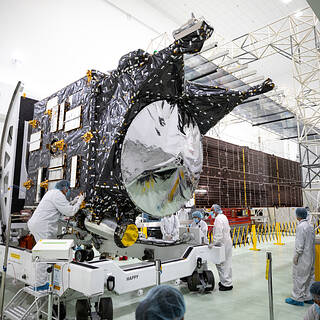Hundred-year storms? That's how long they last on Saturn.
Wednesday, 16 August 2023 09:27 The largest storm in the solar system, a 10,000-mile-wide anticyclone called the Great Red Spot, has decorated Jupiter's surface for hundreds of years.
A new study now shows that Saturn - though much blander and less colorful than Jupiter - also has long-lasting megastorms with impacts deep in the atmosphere that persist for centuries.
The study was conducted by astronomers from the
The largest storm in the solar system, a 10,000-mile-wide anticyclone called the Great Red Spot, has decorated Jupiter's surface for hundreds of years.
A new study now shows that Saturn - though much blander and less colorful than Jupiter - also has long-lasting megastorms with impacts deep in the atmosphere that persist for centuries.
The study was conducted by astronomers from the After capturing image of black hole, what's next?
Wednesday, 16 August 2023 09:27 Agroup of international researchers led by the Center for Astrophysics | Harvard and Smithsonian (CfA) achieved the once-unimaginable four years ago: using a groundbreaking telescope to capture an image of a black hole.
Last month some of those researchers, engineers, and physicists convened at Harvard to consider and begin drawing up plans for the next step: a closer study of the photon r
Agroup of international researchers led by the Center for Astrophysics | Harvard and Smithsonian (CfA) achieved the once-unimaginable four years ago: using a groundbreaking telescope to capture an image of a black hole.
Last month some of those researchers, engineers, and physicists convened at Harvard to consider and begin drawing up plans for the next step: a closer study of the photon r RTX to develop platform agnostic, beyond-line-of-sight, satcoms
Wednesday, 16 August 2023 09:27 Collins Aerospace, an RTX (NYSE: RTX) business, has been awarded a $36 million contract from the U.S. Air Force Research Laboratory to develop and demonstrate a platform-agnostic, Beyond-Line-Of-Sight, satellite communications pod.
The communications pod will provide warfighters resilient, high bandwidth, low latency communications and data directly to the cockpit. The pod brings together
Collins Aerospace, an RTX (NYSE: RTX) business, has been awarded a $36 million contract from the U.S. Air Force Research Laboratory to develop and demonstrate a platform-agnostic, Beyond-Line-Of-Sight, satellite communications pod.
The communications pod will provide warfighters resilient, high bandwidth, low latency communications and data directly to the cockpit. The pod brings together Talking with Webb using the Deep Space Network
Wednesday, 16 August 2023 08:55
NASA's James Webb Space Telescope is nearly 1 million miles (1.5 million kilometer) away from Earth, orbiting around the sun-Earth Lagrange point 2. How do we send commands and receive telemetry—the science and engineering data from the observatory—from that far away? We use the DSN (Deep Space Network) to communicate with the observatory. We receive data when we have a contact with Webb using a DSN antenna
Sandy Kwan, the mission interface manager for Webb within the DSN, notes that "each mesmerizing Webb image that has graced our screens would not have been possible without the support of the DSN antennas and personnel, the backbone of interplanetary communication."
The DSN has three sites around the world, each positioned 120 degrees apart. There are antennas in Goldstone, California; Canberra, Australia; and Madrid, Spain. This allows us to communicate with Webb at any time of day, as the Earth rotates. The DSN is managed by NASA's Jet Propulsion Laboratory (JPL) in Southern California.
Russia's Luna-25 probe enters Moon orbit
Wednesday, 16 August 2023 08:53
Moscow's Luna-25 lander is due to reach the moon's orbit Wednesday, in the first such Russian mission in almost 50 years, according to the schedule of space agency Roscosmos.
With the lunar launch, Moscow's first since 1976, Russia is seeking to restart and rebuild on the Soviet Union's pioneering space program.
The lander is set to revolve 100 kilometers (62 miles) above the moon's surface, before a planned landing Monday north of the Boguslawsky crater on the lunar south pole.
Cameras installed on the lander have already taken distant shots of the Earth and moon from space, Roscosmos said.
The lander, weighing around 800 kilograms (1,764 pounds), was carried into space by a Soyuz rocket launched Friday from the Vostochny cosmodrome in Russia's Far East.
It is due to stay on the moon for a year, where it is tasked with collecting samples and analyzing soil.
The mission comes as the future of Russia's long-running cooperation with the West in space looks in doubt, as Moscow presses ahead with its offensive in Ukraine.
Russia said it would go ahead with its own lunar plans, despite the European Space Agency (ESA) announcing it would not cooperate with Moscow on future missions over its actions in Ukraine.
Astra seeks strategic investors as cash reserves decrease
Tuesday, 15 August 2023 21:32

NRO to select providers of new forms of optical satellite imagery
Tuesday, 15 August 2023 20:08

NASA's Europa probe gets a hotline to Earth
Tuesday, 15 August 2023 19:25
NASA's Europa Clipper is designed to seek out conditions suitable for life on an ice-covered moon of Jupiter. On Aug. 14, the spacecraft received a piece of hardware central to that quest: the massive dish-shaped high-gain antenna.
Stretching 10 feet (3 meters) across the spacecraft's body, the high-gain antenna is the largest and most prominent of a suite of antennas on Europa Clipper. The spacecraft will need it as it investigates the ice-cloaked moon that it's named after, Europa, some 444 million miles (715 million kilometers) from Earth. A major mission goal is to learn more about the moon's subsurface ocean, which might harbor a habitable environment.
Once the spacecraft reaches Jupiter, the antenna's radio beam will be narrowly directed toward Earth. Creating that narrow, concentrated beam is what high-gain antennas are all about.
La NASA invita a los medios al lanzamiento de Psyche
Tuesday, 15 August 2023 17:45 Ya está abierto el proceso de acreditación de los medios de comunicación para el próximo lanzamiento de la nave espacial Psyche de la NASA en su misión a un asteroide único y rico en metales que orbita alrededor del Sol, entre Marte y Júpiter.
Ya está abierto el proceso de acreditación de los medios de comunicación para el próximo lanzamiento de la nave espacial Psyche de la NASA en su misión a un asteroide único y rico en metales que orbita alrededor del Sol, entre Marte y Júpiter. NASA Invites Media to Psyche Launch, Mission will Study an Asteroid
Tuesday, 15 August 2023 17:23 Media accreditation is now open for the upcoming launch of NASA’s Psyche spacecraft, for a mission to a unique metal-rich asteroid orbiting the Sun between Mars and Jupiter.
Media accreditation is now open for the upcoming launch of NASA’s Psyche spacecraft, for a mission to a unique metal-rich asteroid orbiting the Sun between Mars and Jupiter. U.S. deactivates GSSAP surveillance satellite, two new ones in the works
Tuesday, 15 August 2023 17:03

Download the 2023 Small Satellite Conference Dailies Wrap up
Tuesday, 15 August 2023 13:49


 Image:
Edge of earthquake zone
Image:
Edge of earthquake zone 


